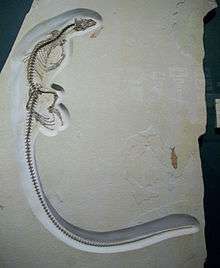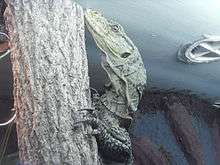Varanidae
The Varanidae are a family of lizards in the superfamily Varanoidea. The family, a group of carnivorous and frugivorous lizards,[1] includes the living genus Varanus, the extinct Megalania (the largest known land-dwelling lizard), and a number of other extinct taxa. Varanus includes the Komodo dragon (the largest living lizard), crocodile monitor, savannah monitor, the goannas of Australia and Southeast Asia, and various other species with a similarly distinctive appearance. Their closest living relatives are the anguid and helodermatid lizards.[2]
| Varanids | |
|---|---|
_fighting.jpg) | |
| male Komodo dragons fighting, Indonesia | |
.jpg) | |
| Nile monitor, Kenya | |
| Scientific classification | |
| Kingdom: | Animalia |
| Phylum: | Chordata |
| Class: | Reptilia |
| Order: | Squamata |
| Superfamily: | Varanoidea |
| Family: | Varanidae Merrem, 1820 |
| Genera | |
Taxonomy
The Varanidae were defined by Estes, de Queiroz and Gauthier (1988) as the clade containing the most recent common ancestor of Lanthanotus and Varanus and all of its descendants.[3] A similar definition was formulated by Conrad et al. (2008), who defined the Varanidae as the clade containing Varanus varius, Lanthanotus borneensis, and all descendants of their last common ancestor.[4] Using one of these definitions leads to the inclusion of the earless monitor lizard (L. borneensis) in the family Varanidae.
Lee (1997) created a different definition of the Varanidae, defining them as the clade containing Varanus and all taxa more closely related to Varanus than to Lanthanotus;[5][6] this definition explicitly excludes the earless monitor lizard from the Varanidae. Whether L. borneensis is included in or excluded from the Varanidae depends on the author; for example, Vidal et al. (2012) classify the earless monitor lizard as a member of a separate family Lanthanotidae,[7] while Gauthier et al. (2012) classify it as a member of Varanidae.[8]
Genera

- Genera marked with † are extinct
Genera usually included in Varanidae (under subfamily Varaninae according to Conrad et al., 2008)):
- †Iberovaranus Hoffstetter, 1969 - Considered to be a junior synonym of Varanus by Delfino et al. (2013).[9]
- †Ovoo Norell, Gao, & Conrad, 2008[10]
- †Saniwa Leidy, 1870
- Varanus Shaw, 1790
Genera sometimes included in the Varanidae (under subfamily Lanthanotinae according to Conrad et al., 2008), treated as under the separate family Lanthanotidae by other authors:
- †Aiolosaurus Gao and Norell, 2000[10]
- †Cherminotus Borsuk-Bialynicka, 1984
- Lanthanotus Steindachner, 1878
Basal varanoids:
- †Saniwides Borsuk-Bialynicka, 1984
- †Telmasaurus Gilmore, 1943[10]
- †Palaeosaniwa Gilmore, 1928 - Might actually be more closely related to helodermatids than to varanids.[4]
Formerly included in the Varanidae:
Phylogeny
Below is a cladogram from Conrad et al. (2008) that shows relationships within Varanoidea:[12]
| Varanoidea |
| ||||||||||||||||||||||||||||||||||||||||||||||||||||||||||||
Biology

Monitor lizards are reputed to be among the most intelligent lizards. Most species forage widely and have large home ranges,[13] and many have high stamina.[14] Although most species are carnivorous, three arboreal species in the Philippines (Varanus olivaceus, Varanus mabitang, and Varanus bitatawa) are primarily frugivores.[1][15] Among species of living varanids, the limbs show positive allometry, being larger in larger-bodied species, although the feet become smaller as compared with the lengths of the other limb segments.[16]
Varanids possess unidirectional pulmonary airflow, including airsacs akin to those of birds.[17]
References
- Welton, L. J.; Siler, C. D.; Bennett, D.; Diesmos, A.; Duya, M. R.; Dugay, R.; Rico, E. L. B.; Van Weerd, M.; Brown, R. M. (2010). "A spectacular new Philippine monitor lizard reveals a hidden biogeographic boundary and a novel flagship species for conservation". Biology Letters. 6 (5): 654–658. doi:10.1098/rsbl.2010.0119. ISSN 1744-9561. PMC 2936141. PMID 20375042.
- Fry, B.G.; Vidal, N; Norman, J.A.; Vonk, F.J.; Scheib, H.; Ramjan, S.F.R; Kuruppu, S.; Fung, K.; Hedges, B.; Richardson, M.K.; Hodgson; Ignjatovic, V.; Summerhays, R.; Kochva, E. (February 2006). "Early evolution of the venom system in lizards and snakes". Nature. 439 (7076): 584–588. doi:10.1038/nature04328. PMID 16292255.
- de Queiroz, Kevin; Gauthier, Jacques (1988). "Phylogenetic Relationships within Squamata". In Estes, Richard J.; Pregill, Gregory K. (eds.). Phylogenetic Relationships of the Lizard Families: Essays Commemorating Charles L. Camp. Stanford University Press. p. 166. ISBN 9780804714358. OCLC 16646258.
- Conrad, J. (2008). "Phylogeny and systematics of Squamata (Reptilia) based on morphology". Bulletin of the American Museum of Natural History. 310: 1–182. doi:10.1206/310.1. hdl:2246/5915.
- Lee, Michael S. Y. (29 January 1997). "The phylogeny of varanoid lizards and the affinities of snakes". Philos Trans R Soc Lond B Biol Sci. The Royal Society. 352 (1349): 53–91. doi:10.1098/rstb.1997.0005. PMC 1691912.
- Lee, Michael S. Y. (2005). "Molecular evidence and marine snake origins". Biology Letters. 1 (2): 227–230. doi:10.1098/rsbl.2004.0282. PMC 1626205. PMID 17148173.
- Vidal, Nicolas; Marin, Julie; Sassi, Julia; Battistuzzi, Fabia U.; Donnellan, Steve; Fitch, Alison J.; Fry, Bryan G.; Vonk, Freek J.; Rodriguez de la Vega, Ricardo C.; Couloux, Arnaud; Hedges, S. Blair (2012). "Molecular evidence for an Asian origin of monitor lizards followed by Tertiary dispersals to Africa and Australasia". Biology Letters. 8 (5): 853–855. doi:10.1098/rsbl.2012.0460. PMC 3441001. PMID 22809723.
- Gauthier, Jacques A.; Kearney, Maureen; Maisano, Jessica Anderson; Rieppel, Olivier; Behlke, Adam D.B. (2012). "Assembling the Squamate Tree of Life: Perspectives from the Phenotype and the Fossil Record". Bulletin of the Peabody Museum of Natural History. 53 (1): 3–308. doi:10.3374/014.053.0101.
- Delfino, Massimo; Rage, Jean-Claude; Bolet, Arnau; Alba, David M. (2013). "Early Miocene dispersal of the lizard Varanus into Europe:Reassessment of vertebral material from Spain". Acta Palaeontologica Polonica. 58 (4): 731–735. doi:10.4202/app.2012.0025.
- Conrad, JL; Balcarcel, AM; Mehling, CM (2012). "Earliest Example of a Giant Monitor Lizard (Varanus, Varanidae, Squamata)". PLoS ONE. 7 (8): e41767. doi:10.1371/journal.pone.0041767. PMC 3416840. PMID 22900001.
- Houssaye, Alexandra; Bardet, Nathalie; Rage, Jean–Claude; Suberbiola, Xabier Pereda; Bouya, Baâdi; Amaghzaz, Mbarek; Amalik, Mohamed (2011). "A review of Pachyvaranus crassispondylus Arambourg, 1952, a pachyostotic marine squamate from the latest Cretaceous phosphates of Morocco and Syria". Geological Magazine. 148 (2): 237–249. doi:10.1017/S0016756810000580.
- Conrad, Jack L.; Rieppel, Olivier; Grande, Lance (31 December 2008). "Re-assessment of varanid evolution based on new data from Saniwa ensidens Leidy, 1870 (Squamata, Reptilia)" (PDF). American Museum Novitates (3630): 1–15. doi:10.1206/596.1. hdl:2246/5939.
- Perry, G.; Garland, T., Jr. (2002). "Lizard home ranges revisited: effects of sex, body size, diet, habitat, and phylogeny" (PDF). Ecology. 83 (7): 1870–1885. doi:10.1890/0012-9658(2002)083[1870:LHRREO]2.0.CO;2.
- Clemente, C.J.; Withers, P.C.; Thompson, G.G. (2009). "Metabolic rate and endurance capacity in Australian varanid lizards (Squamata; Varanidae; Varanus)". Biological Journal of the Linnean Society. 97 (3): 664–676. doi:10.1111/j.1095-8312.2009.01207.x.
- Greene, Harry W. (1986). Diet and Arboreality in the Emerald Monitor, Varanus prasinus, with Comments on the Study of Adaptation. Chicago: Field Museum of Natural History. OCLC 14915452. OL 7155983M.
- Christian, A.; Garland, T., Jr. (1996). "Scaling of limb proportions in monitor lizards (Squamata: Varanidae)" (PDF). Journal of Herpetology. 30 (2): 219–230. doi:10.2307/1565513. JSTOR 1565513.
- Unidirectional Airflow In The Lungs Of Birds, Crocs And Now Monitor Lizards